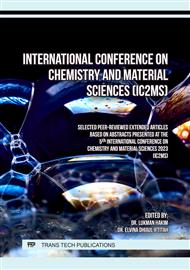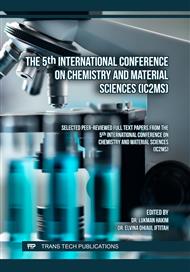p.3
p.13
p.23
p.33
p.45
p.55
p.61
Binding Affinities of Hyptolide and its Derivatives onto HDAC Class IIa Protein from In Silico Analysis
Abstract:
HDAC proteins play a role in epigenetic changes in cancer-causing gene expression. Previous research reported that hyptolide and its derivatives inhibited several cancer cell growths in vitro. However, the potential of this anticancer compounds in preventing HDAC protein activity has not yet been evaluated. This study aims to determine the site-related inhibitory activity and binding affinity produced by hyptolide against HDAC class IIa protein compared to its derivative complexes. Hyptolide and its derivatives have previously been optimized using ORCA software with B3LYP/6-31G** functional DFT theory. The optimization results on the hyptolide molecule show that the partial charge values of O4, O5, O6, and O7 atoms in the OAc group are -0.437; -0.444; -0.436, and -0.431 with a dipole moment 5.47363 Debye, while the partial charges of hyptolide derivatives on the same atom for epoxy-hyptolide are -0.465; -0.454; -0.448, and -0.415 with dipole moment value 8.57293 Debye and dimethylphenylamine-hyptolide molecules are -0.456; -0.442; -0.559 and -0.418 and dipole moment value 8.86020 Debye. The pharmacokinetics and class toxicity test of ligand compound show that the dimethylphenylamine-hyptolide has highest class toxicity, and it is more toxic than hyptolide and epoxy-hyptolide. The molecular docking process was conducted using AutoDock Vina software. The active site of amino acid residue that interacts with each ligand is Asp B 801 and Val B 708. In line with the partial charge value of the optimized hyptolide compound and its derivatives, binding affinity value complex with dimethylphenylamine-hyptolide ligand compound had the lowest binding affinitiy value in first conformation of -11.00. These results confirm that prediction of hyptolide derivative compounds with nitrogen group as alkylating agents will decrease the binding affinity between ligands and proteins. These results motivate researchers to conduct further studies on the activity of hyptolide derivative compounds in dimethylphenylamine-hyptolide against cancer cell growth in vitro and how to decrease its toxicity.
Info:
Periodical:
Pages:
3-11
Citation:
Online since:
July 2024
Authors:
Price:
Сopyright:
© 2024 Trans Tech Publications Ltd. All Rights Reserved
Share:
Citation:



